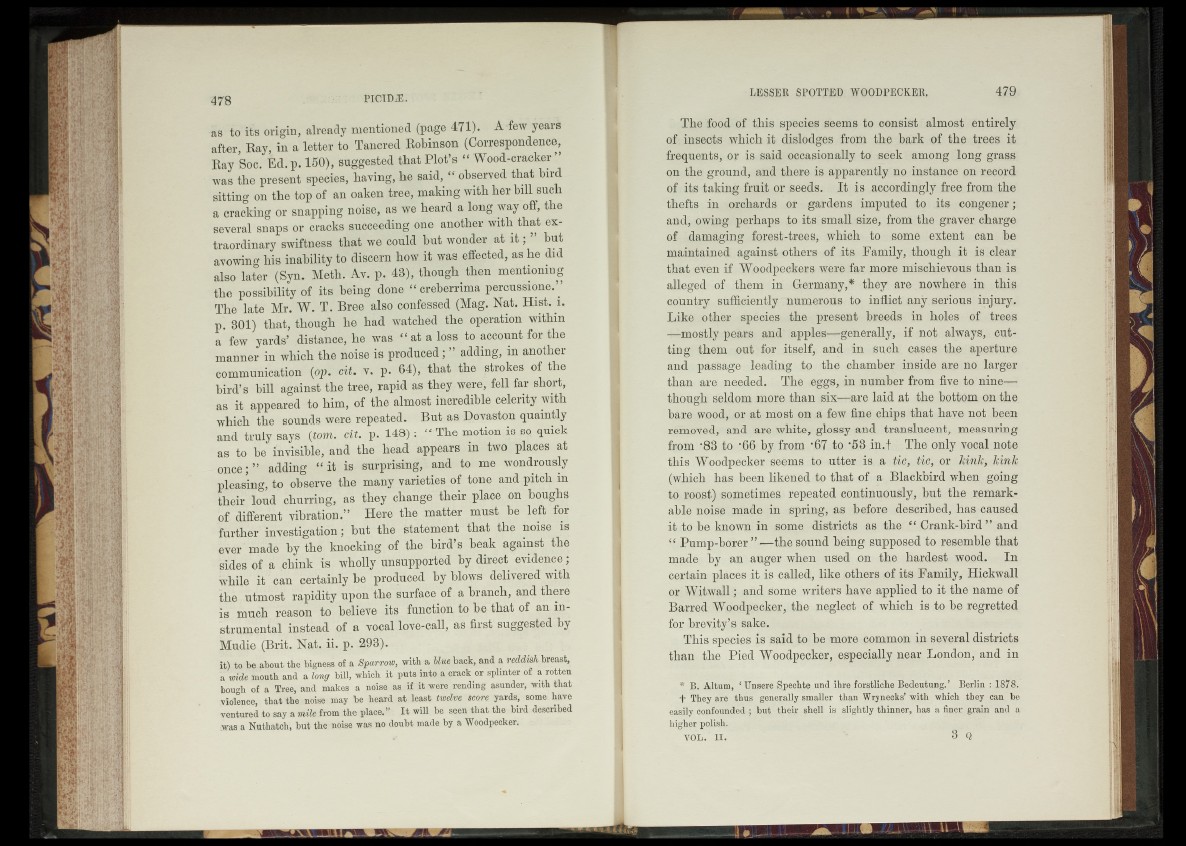
as to its origin, already mentioned (page 471). A few years
after, Kay, in a letter to Tancred Robinson (Correspondence,
Ray Soc. Ed. p. 150), suggested that Plot’s “ Wood-cracker
was the present species, having, he said, “ observed that bird
sitting on the top of an oaken tree, making with her bill such
a cracking or snapping noise, as we heard a long way off, the
several snaps or cracks succeeding one another with that extraordinary
swiftness that we could but wonder at i t ; ” but
avowing his inability to discern how it was effected, as he did
also later (Syn. Meth. Av. p. 48), though then mentioning
the possibility of its being done “ creberrima percussione.”
The late Mr. W. T. Bree also confessed (Mag. Nat. Hist. i.
p. 301) that, though he had watched the operation within
a'few yards’ distance, he was “ at a loss to account for the
manner in which the noise is produced; ” adding, in another
communication (op. cit. v. p. 64), that the strokes of the
bird’s bill against the tree, rapid as they were, fell far short,
as it appeared to him, of the almost incredible celerity with
which the sounds were repeated. But as Dovaston quaintly
and truly says (tom. cit. p. 148): “ The motion is so quick
as to be invisible, and the head appears in two places at
once;” adding “ it is surprising, and to me wondrously
pleasing, to observe the many varieties of tone and pitch in
their loud churring, as they change their place on boughs
of different vibration.” Here the matter must be left for
further investigation; but the statement that the noise is
ever made by the knocking of the bird’s beak against the
sides of a chink is wholly unsupported by direct evidence ;
while it can certainly be produced by blows delivered with
the utmost rapidity upon the surface of a branch, and there
is much reason to believe its function to be that of an instrumental
instead of a vocal love-call, as first suggested by
Mudie (Brit. Nat. ii. p. 293).
it) to be about the bigness of a Sparrow, with a blue back, and a reddish breast,
a wide mouth and a long bill, which it puts into a crack or splinter of a rotten
bough of a Tree, and makes a noise as if it were rending asunder, with that
violence, that the noise may be heard at least twelve score yards, some have
ventured to say a mile from the place.” I t will be seen that the bird described
was a Nuthatch, but the noise was no doubt made by a Woodpecker.
The food of this species seems to consist almost entirely
of insects which it dislodges from the bark of the trees it
frequents, or is said occasionally to seek among long grass
on the ground, and there is apparently no instance on record
of its taking fruit or seeds. It is accordingly free from the
thefts in orchards or gardens imputed to its congener;
and, owing perhaps to its small size, from the graver charge
of damaging forest-trees, which to some extent can be
maintained against others of its Family, though it is clear
that even if Woodpeckers were far more mischievous than is
alleged of them in Germany,* they a re , nowhere in this
country sufficiently numerous to inflict any serious injury.
Like other species the present breeds in holes of trees
—mostly pears and apples—generally, if not always, cutting
them out for itself, and in such cases the aperture
and passage leading to the chamber inside are no larger
than are needed. The eggs, in number from five to nine—
though seldom more than six—are laid at the bottom on the
bare wood, or at most on a few fine chips that have not been
removed, and are white, glossy and translucent, measuring
from '83 to '66 by from *67 to ’53 in.f The only vocal note
this Woodpecker seems to utter is a tic, tic, or kink, kink
(which has been likened to that of a Blackbird when going
to roost) sometimes repeated continuously, but the remarkable
noise made in spring, as before described, has caused
it to be known in some districts as the “ Crank-bird” and
“ Pump-borer ”—the sound being supposed to resemble that
made by an auger when used on the hardest wood. In
certain places it is called, like others of its Family, Hickwall
or Witwall; and some writers have applied to it the name of
Barred Woodpecker, the neglect of which is to be regretted
for brevity’s sake.
This species is said to be more common in several districts
than the Pied Woodpecker, especially near London, and in
* B. Altum, ‘ Unsere Spechte und ihre forstlicbe Bedeutung.’ Berlin : 1878.
+ They are thus generally smaller than Wrynecks’ with which they can be
easily confounded ; but their shell is slightly thinner, has a finer grain and a
higher polish.
VOL. II. • 3 Q